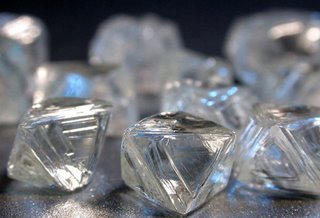Diamonds, mining for dust
Following the world wide opening of the movie Blood Diamonds in theaters this week, attention has once again focused on the illicit trade in African “conflict” diamonds. Diamond merchants everywhere are scrambling to convince consumers that their stones conflict free locations. however the truth remains that, no supplier - not even vaunted De Beers - can guarantee a diamond's origin at the retail level.
Diamonds come onto the market by a variety of routes including: brokers, archived stores and retrieved (recycled sources). In fact, where your diamond actually came from is probably as much a mystery to the retailer as to you.
 Surface mining, in all its forms, for whatever treasure lies beneath, leaves giant scar on the planet (see our report Green grow the diamonds, Jan 06) as well as scars upon a society that tolerates it. For years, Diamond mining has disrupted the landscape of continents from Africa to the Arctic. Mining interests continue to exploit human and environmental resources in order to glean the merest “dust” of diamonds.
Surface mining, in all its forms, for whatever treasure lies beneath, leaves giant scar on the planet (see our report Green grow the diamonds, Jan 06) as well as scars upon a society that tolerates it. For years, Diamond mining has disrupted the landscape of continents from Africa to the Arctic. Mining interests continue to exploit human and environmental resources in order to glean the merest “dust” of diamonds.
Roughly, 49% of all diamonds originate from central and southern Africa; and significant sources of the mineral have been discovered in Canada, India, Russia, Brazil, and Australia. Generally, diamonds are mined from volcanic vents called pipes buried deep in the Earth where high pressure and temperature enable formation of the crystal.
Annually, 26,000 kg of “graded” diamonds are mined, with a value estimated in USD of $9 billion (1 kilogram equals just over 35 ounces or 2.2 lbs), that equals roughly 29 tons of raw diamond mined each year. The total weight of the earth is 5972 sextillion tons, by comparison, just dust. But the damage it does to the planet and people who work the mine fields is enormous.
 Mining and the distribution of natural diamonds frequently raise concerns, about the sale of conflict diamonds – blood diamonds - by African paramilitary groups. Allegations that De Beers misuses its dominance in the industry to control supply and manipulate price abound. Yet, even as 'De Beers’ market share has dropped below 60%, there are other companies rising to fill the void. (Video interview with Manager, DeBeers' Snap Lake Project.)
Mining and the distribution of natural diamonds frequently raise concerns, about the sale of conflict diamonds – blood diamonds - by African paramilitary groups. Allegations that De Beers misuses its dominance in the industry to control supply and manipulate price abound. Yet, even as 'De Beers’ market share has dropped below 60%, there are other companies rising to fill the void. (Video interview with Manager, DeBeers' Snap Lake Project.)
Diamond sales yearly reap enormous profits for globalized mining corporations returning but a small fraction of the revenues to local economies, Mining, as it has always in the past, creates boomtowns, only to be followed by abandoned claims, scarred earth and devastated economies. Considering these sobering consequences, perhaps diamonds are forever.
by Harlan Weikle
Greener Magazine
Keywords:: DIAMONDS CONFLICT BOOMTOWNS SURFACE MINING
Diamonds come onto the market by a variety of routes including: brokers, archived stores and retrieved (recycled sources). In fact, where your diamond actually came from is probably as much a mystery to the retailer as to you.
 Surface mining, in all its forms, for whatever treasure lies beneath, leaves giant scar on the planet (see our report Green grow the diamonds, Jan 06) as well as scars upon a society that tolerates it. For years, Diamond mining has disrupted the landscape of continents from Africa to the Arctic. Mining interests continue to exploit human and environmental resources in order to glean the merest “dust” of diamonds.
Surface mining, in all its forms, for whatever treasure lies beneath, leaves giant scar on the planet (see our report Green grow the diamonds, Jan 06) as well as scars upon a society that tolerates it. For years, Diamond mining has disrupted the landscape of continents from Africa to the Arctic. Mining interests continue to exploit human and environmental resources in order to glean the merest “dust” of diamonds. Roughly, 49% of all diamonds originate from central and southern Africa; and significant sources of the mineral have been discovered in Canada, India, Russia, Brazil, and Australia. Generally, diamonds are mined from volcanic vents called pipes buried deep in the Earth where high pressure and temperature enable formation of the crystal.
Annually, 26,000 kg of “graded” diamonds are mined, with a value estimated in USD of $9 billion (1 kilogram equals just over 35 ounces or 2.2 lbs), that equals roughly 29 tons of raw diamond mined each year. The total weight of the earth is 5972 sextillion tons, by comparison, just dust. But the damage it does to the planet and people who work the mine fields is enormous.
 Mining and the distribution of natural diamonds frequently raise concerns, about the sale of conflict diamonds – blood diamonds - by African paramilitary groups. Allegations that De Beers misuses its dominance in the industry to control supply and manipulate price abound. Yet, even as 'De Beers’ market share has dropped below 60%, there are other companies rising to fill the void. (Video interview with Manager, DeBeers' Snap Lake Project.)
Mining and the distribution of natural diamonds frequently raise concerns, about the sale of conflict diamonds – blood diamonds - by African paramilitary groups. Allegations that De Beers misuses its dominance in the industry to control supply and manipulate price abound. Yet, even as 'De Beers’ market share has dropped below 60%, there are other companies rising to fill the void. (Video interview with Manager, DeBeers' Snap Lake Project.) Diamond sales yearly reap enormous profits for globalized mining corporations returning but a small fraction of the revenues to local economies, Mining, as it has always in the past, creates boomtowns, only to be followed by abandoned claims, scarred earth and devastated economies. Considering these sobering consequences, perhaps diamonds are forever.
by Harlan Weikle
Greener Magazine
Keywords:: DIAMONDS CONFLICT BOOMTOWNS SURFACE MINING



9:30 AM









<< Home